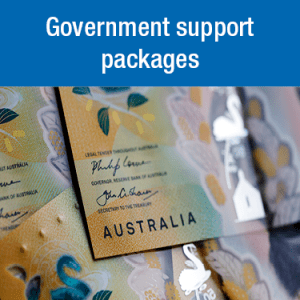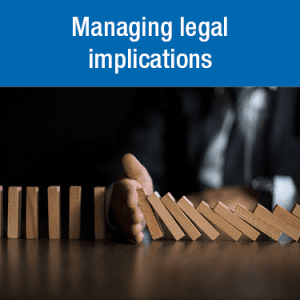What is JobKeeper 2.0?
Information last updated 18 September 2020.
JobKeeper 2.0 is the next phase of the JobKeeper scheme that applies from 28 September 2020 to 28 March 2021.
Under this next phase, the core JobKeeper eligibility rules continue to apply but with some adjustments. There are also some new aspects, including:
- An additional test which requires the actual turnover of the entity to have sufficiently declined;
- Changes to the payment rate (and which individuals qualify for a particular rate); and
- Some additional notification requirements.
Actual decline in turnover test
- For an entity to qualify for JobKeeper payments for fortnights beginning on or after 28 September 2020, they must satisfy a new actual decline in turnover test.
- This test must be satisfied in addition to the original decline in turnover test (and all other conditions under the scheme)
- Whilst the original decline in turnover test considers the projected GST turnover of an entity, the actual decline in turnover considers the current GST turnover of an entity (i.e. the actual GST turnover)
- Under this test, an entity will need to demonstrate that their actual GST turnover for a quarter has declined by a certain percentage compared to their actual GST turnover for the comparable quarter in 2019 (relevant comparison period). Certain alternative tests may be available in limited circumstances.
- The relevant decline percentage will be the same as for the initial phase of JobKeeper i.e. 15%, 30% or 50% depending on the type of entity and its aggregated turnover.
- This test will need to be satisfied in respect of two periods based on specified quarters, as follows:
- First Period: To access JobKeeper payments for the fortnights between 28 September 2020 and 3 January 2020 (inclusive), an entity must compare its actual GST turnover for the quarter ending 30 September 2020 to its actual GST turnover for the quarter ended 30 September 2019 (or such alternative comparison period as may apply under an alternative test)
- Second Period: To access JobKeeper payments for the fortnights between 4 January 2021 and 28 March 2021 (inclusive), an entity must compare its actual GST turnover for the quarter ending 31 December 2020 to its actual GST turnover in the quarter ended 31 December 2019 (or such alternative comparison period as may apply under an alternative test).
How is 'GST turnover' determined?
- GST turnover is currently determined based on when supplies are made and not the period to which any tax payable on the supplies is attributable. However, some taxpayers are required to report their supplies based on “attribution” in their Business Activity Statements (BAS).
- To address this complexity, the Commissioner has released guidance on how GST turnover is to be calculated for the purposes of the actual decline in turnover test.
- Generally, if an entity is registered for GST, the entity should be using the information as disclosed on their BAS for the particular period as the basis to determine its GST turnover for that period. Hence if the entity prepares its BAS on a cash basis, it should use the cash basis to determine its GST turnover. Similarly, if the BAS was prepared on a non-cash (accruals) basis, that method would be used to determine GST turnover.
- If an entity is not (and has never been) registered for GST, the entity may choose its own accounting basis for determining when its supplies are made (i.e. on either a cash basis or a non-cash basis). However, it will need to use the same accounting basis for calculating GST turnover for each test period.
- In all other cases, an entity will be required to work out when its supplies are made in accordance with the following criteria:
- If an entity has always been registered for GST and never changed their accounting basis, the entity needs to use that accounting
- If an entity is registered for GST at the beginning of the relevant comparison period, the entity needs to use the accounting basis from the first tax period of the relevant comparison period.
- If the entity became registered for GST during the relevant comparison period, the entity needs to use the accounting basis from the first tax period of the relevant comparison period.
- If an entity changed their accounting basis during or after the start of the relevant comparison period, the entity needs to use the accounting basis from the first tax period of the relevant comparison period.
- If an entity cancelled their GST registration during or after the relevant comparison period, the entity needs to use the accounting basis from the first tax period of the relevant comparison period.
- If an entity registered for GST after the end of the relevant comparison period, the entity needs to use the accounting basis at the beginning of its turnover test period.
Does an entity need to satisfy the actual decline in turnover test for both quarters?
- If an entity does not satisfy the actual decline in turnover test for the September 2020 quarter, it will not be able to access JobKeeper for the period 28 September 2020 to 3 January 2021, but it may still be able to access the JobKeeper payments for those fortnights in the Second Period (i.e. for fortnights beginning on or after 4 January 2021) if it satisfies the actual decline in turnover test for the December 2020 quarter.
- An entity does not need to have participated in the initial phase of the JobKeeper scheme (i.e. at any point during the first six months through until 27 September 2020), to be able to access the JobKeeper payment for fortnights beginning on or after 28 September 2020. However, it will still need to meet all of the relevant qualifying criteria.
Actual decline in turnover test – alternative tests
- In some circumstances, entities may be able to apply an alternative test for determining their actual decline in turnover.
- Although the details of these tests have not yet been released, it is expected those tests will apply in a similar way to the alternative tests for the original decline in turnover test. However, further guidance on these tests is expected to be released by the Commissioner very soon.
Interaction between the original decline in turnover test and the actual decline in turnover test
- The actual decline in turnover test is an additional test that needs to be satisfied and does not replace the original projected decline in turnover test.
- If an entity has qualified for the JobKeeper scheme prior to 28 September 2020 (i.e. the initial phase of JobKeeper), it is not required to re-test its projected decline in turnover to continue on in the JobKeeper scheme from 28 September 2020 (it instead needs to satisfy the actual decline in turnover test).
- However, if an entity did not qualify for the JobKeeper scheme prior to 28 September 2020, it will need to satisfy both the projected decline in turnover test (with some modifications) and the new actual decline in turnover test.
Modifications to the original decline in turnover test:
- If an entity is required to satisfy the original projected decline in turnover test, they can still choose to compare their “projected GST turnover” for a relevant month or quarter. Depending on when they are looking to register, the following projection periods may be relevant:
- The month of September 2020;
- The month of October 2020;
- The month of November 2020;
- The month of December 2020;
- The quarter ending on 30 September 2020; or
- The quarter ending on 31 December 2020.
- Aside from this change, the new rules have not introduced any other changes to the application of the original projected decline in turnover test
- Given the overlap between the actual decline in turnover test for the First and Second Periods and the modified original decline in turnover test, it is expected that an entity would satisfy the original test if they satisfied the actual test
Payment rates for eligible employees
- JobKeeper extension incorporates a two-tier payment rate system. The applicable rate for an employee will depend on the total hours of work, paid leave and paid absence on public holidays over the applicable reference period.
| JobKeeper fortnights beginning on or after 28 September 2020 | JobKeeper fortnights beginning on or after 4 January 2021 | |
| Higher payment rate: 80 hours or more in reference period | $1,200 per fortnight | $1,000 per fortnight |
| Lower payment rate: Less than 80 hours in reference period | $750 per fortnight | $650 per fortnight |
Steps for working out the rate of JobKeeper payment for an eligible employee
- Reference Period: Identify the relevant reference period(s) which is used to determine whether the higher or lower rate of JobKeeper payment is payable for an eligible employee. All reference periods that could apply to the particular employee need to be considered. The reference periods are:
-
- the 28-day period ending at the end of the most recent pay cycle for the employee before 1 March 2020; or
- the 28-day period ending at the end of the most recent pay cycle for the employee before 1 July 2020; or
- an alternative reference period determined by the Commissioner.
- Calculate Total Hours: Calculate the hours for each employee in each reference period identified in step 1. Hours include actual hours worked, paid leave and paid absence for public holidays.
- Note that for pay cycles covering a period greater than 28 days (e.g. monthly), the hours calculated need to be pro-rated over 28 days.
- Determining Which Rate Applies: If the total hours calculated for at least one of these periods is 80 hours or more, the higher rate of JobKeeper payment will apply to that employee. Otherwise the lower payment rate will apply to the employee.
Alternative reference periods for eligible employees
- In determining whether the higher rate of JobKeeper applies for an eligible employee, the Commissioner has determined the following circumstances where an alternative reference period will be applicable:
- If the total hours of the employee in the standard reference period was less than 80 hours and the standard reference period was not representative of typical total hours of the employee;
- The alternative reference period is the 28-day period ending at the end of the most recent pay cycle for the employee before 1 March 2020 or 1 July 2020 in which the employee’s total number of hours of work, of paid leave and of paid absence on public holidays was representative of a typical 28-day period.
- If the employee was not employed by that entity during all or part of the reference period;
- The alternative reference period is the first 28-day period, ending on or after 1 March 2020 or 1 July 2020, that wholly occurs during a pay cycle or consecutive pay cycles.
- If the start of the employee’s employment with that entity was on or before the reference time but their first pay cycle ended on or after the reference time;
- The alternative reference period is the first 28-day period, ending on or after 1 March 2020 or 1 July 2020, that wholly occurs during a pay cycle or consecutive pay cycles.
- If the employee is treated as having also been employed by that entity at an earlier time but the employee was not employed by the entity for all or part of the reference period (i.e. employee was employed by another entity in the same wholly-owned group as their current employer, or where they were employed by a business that has changed hands).
- The alternative reference period is the first 28-day period, ending on or after 1 March 2020 or 1 July 2020, that wholly occurs during a pay cycle or consecutive pay cycles.
Business participants
- The same payment rates apply to the nominated eligible business participant as eligible employees. An entity needs to assess the number of hours that the business participant was actively engaged in the business during the reference period.
Steps for working out the rate of JobKeeper payment for an eligible business participant
- Reference Period: Identify the relevant reference period which is used to determine whether the higher or lower rate of JobKeeper payment is payable for an eligible business participant. The reference period is the whole calendar month of February 2020 unless an alternative reference period determined by the Commissioner applies.
- Calculate Total Hours: To determine whether the higher payment rate applies, calculate the total hours of active engagement by the business participant in the business of the entity over the applicable reference period.
- Determining Which Rate Applies:
a) If 80 hours or more, the business participant must make a declaration in the approved form to the entity that their total hours of active engagement are 80 hours or more for February for the entity to be entitled to the higher JobKeeper payment rate in respect of the eligible business participant.
b) Eligible entities are entitled to receive the lower JobKeeper payment rate for eligible business participants that:
- have hours of active engagement in the business of less thatn 80 hours for the applicable reference period; or
- do not provide a declaration to the entity regardless of whether the hours of active engagement were 80 or more.
Is the individual actively engaged in the business?
- Existing records of engagement may not be held by business participants, but if an entity has not been active during the reference period or had all duties and other activities carried out instead by employees, or if the business participant held a separate full-time job then it would be likely that they would not satisfy this test.
- Business participants and entities must be in a position to reasonably demonstrate the basis on which they determined that a business participant was actively engaged in the business for the required number of hours in the applicable reference period.
Alternative reference periods for eligible business participants
- If total number of hours actively engaged in February 2020 was less than 80 hours and when compared to earlier 29-day periods (each wholly within a calendar month), was not representative of the eligible business participant’s total number of those hours in a typical such 29-day period:
- The alternative reference period is the most recent 29-day period, wholly within a calendar month, ending before 1 March 2020 in which any circumstances that caused the eligible business participant’s total number of hours of active engagement not to be representative of the eligible business participant’s total number of those hours in a typical 29-day period did not exist
- If the individual first began to be an eligible business participant for the entity on or before 1 March 2020 but after 1 February 2020:
- The alternative reference period is the 29-day period starting on the day the individual first began to satisfy the business participation requirement for the entity.
- If the entity conducted business or some of its business in a declared drought zone, or declared natural disaster zone, during February 2020:
- The alternative reference period is the most recent 29-day period ending before 1 March 2020, during which the entity did not conduct business or some of its business in a declared drought zone or declared natural disaster zone.
Religious practitioners
- The same payment rates apply to qualifying religious institutions in respect of their eligible religious practitioners as eligible employees. An entity needs to assess the number of hours that the religious practitioner was doing the relevant activities in pursuit of their vocation as a religious practitioner and as a member of the religious institution during the reference period.
Steps for working out the rate of JobKeeper payment for a religious practitioner
- Reference Period: Identify the relevant reference period which is used to determine whether the higher or lower rate of JobKeeper payment is payable for a religious practitioner. The reference period is the whole calendar month of February 2020 unless an alternative reference period determined by the Commissioner applies.
- Calculate Total Hours: To determine whether the higher payment rate applies, calculate the total hours the religious practitioner was doing the relevant activities in pursuit of their vocation as a religious practitioner and as a member of the religious institution over the applicable reference period.
- Determining Which Rate Applies:
a) Entitled to the higher rate if the religious practitioner:
- spent 80 hours or more doing the relevant activities in pursuit of their vocation as a religious practitioner and as a member of the religious institution over the applicable reference period; and
- has made a declaration in the approved form to the religious institution that their hours of activity were 80 hours or more over an applicable reference period.
b) Eligible entities are entitled to receive the lower JobKeeper payment rate for religious practitioners that:
- have hours of the relevant activity of less than 80 hours for the applicable reference period; or
- do not provide a declaration to the entity regardless of whether the hours of the relevant activity were 80 or more.
Alternative reference periods for religious practitioners
- If total number of hours doing the relevant activities in pursuit of their vocation as a religious practitioner and as a member of the religious institution in February 2020 was less than 80 hours and when compared to earlier 29-day periods (each wholly within a calendar month), was not representative of the eligible religious practitioner’s total number of those hours in a typical such 29-day period:
- The alternative reference period is the most recent 29-day period, wholly within a calendar month, ending before 1 March 2020 in which any circumstances that caused the eligible religious practitioner’s total number of hours of doing the relevant activities in pursuit of their vocation as a religious practitioner and as a member of the religious institution not to be representative of the eligible religious practitioner’s total number of those hours in a typical 29-day period did not exist
- If the individual first began to be an eligible religious practitioner for the entity on or before 1 March 2020 but after 1 February 2020:
- The alternative reference period is the 29-day period starting on the day the individual first commenced doing the relevant activities.
If more than one alternative reference period applies to an individual
- Where more than one alternative reference period can apply to an individual, each of those alternative reference periods can apply to determine whether the total number of hours is 80 or more in that period (i.e. the alternative resulting in the most favourable outcome can be adopted).
Penalties for false and misleading declarations
- If an eligible business participant or a religious practitioner makes a false declaration, they will be liable to penalties for making false and misleading statements under the Taxation Administration Act 1953 (Cth).
What if the 80 hours can’t be readily ascertained from the records of the entity?
- If an entity cannot readily ascertain the hours for a class of individuals, the Commissioner may determine that the higher rate applies to individuals in that class.
- However, an entity must first be able to establish that the information required to determine the hours of a class of individuals is not readily ascertainable (e.g. records do not exist or there are incomplete records of those hours for the relevant period).
- If an entity can ascertain information in respect of the hours of a class of individuals, then the entity must work out the applicable rates using the standard tests above.
- If the required information is not readily ascertainable, the Commissioner can determine that the higher rate will apply to a class of employees in the following limited circumstances:
- Where the amount paid to an individual during the reference period (being a 28 day period) is at least $1,500. This amount includes gross salary, wages, commission, bonus payments and allowances (inclusive of PAYG withholding) and any fringe benefits or superannuation contributions provided under an effective salary sacrifice agreement. However, top up payments made by an entity to satisfy the “wage condition” are not included in this amount.
- Where a written industrial award, employment contract or similar instrument governs the employment relationship of those class of individuals and under that agreement an employee was required to work 80 hours or more in a reference period (including paid leave and paid absence on public holidays).
- Where it can be determined, based on reasonable assumptions, that an employee’s hours in a reference period were 80 hours or more (including paid leave and paid absence on public holidays). For the assumptions to be reasonable, they must be based on verifiable information. This may include information on how an employer’s business usually operates, such as the ordinary business hours, average staffing level in any given week, common shift lengths for certain types of employees and the average number of shifts of employees.
Notifications required to be made
- If an entity has already participated in the JobKeeper scheme, it does not need to notify the Commissioner again that it elects to participate in the scheme for the next phase of JobKeeper from 28 September 2020
- However, to access the JobKeeper payments in respect of fortnights from 28 September 2020, an entity must notify the Commissioner of the rate that applies to any eligible employees, business participants or religious practitioners. An entity will not be eligible for JobKeeper payments for this next phase until a valid notification is made to the Commissioner.
- Entities must also notify individuals in writing within 7 days of advising the Commissioner of the JobKeeper payment rate that applies to the individual
- If an individual considers their rate to be incorrect, they can raise this with their employer for consideration in the first instance. However, if the matter is not resolved with their employer, the individual can escalate the matter to the Fair Work Commission for examination
























